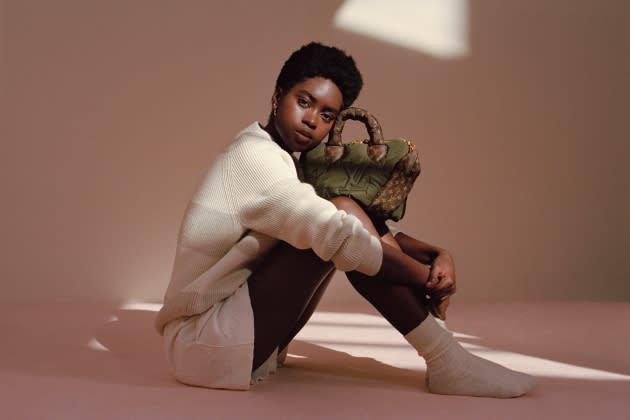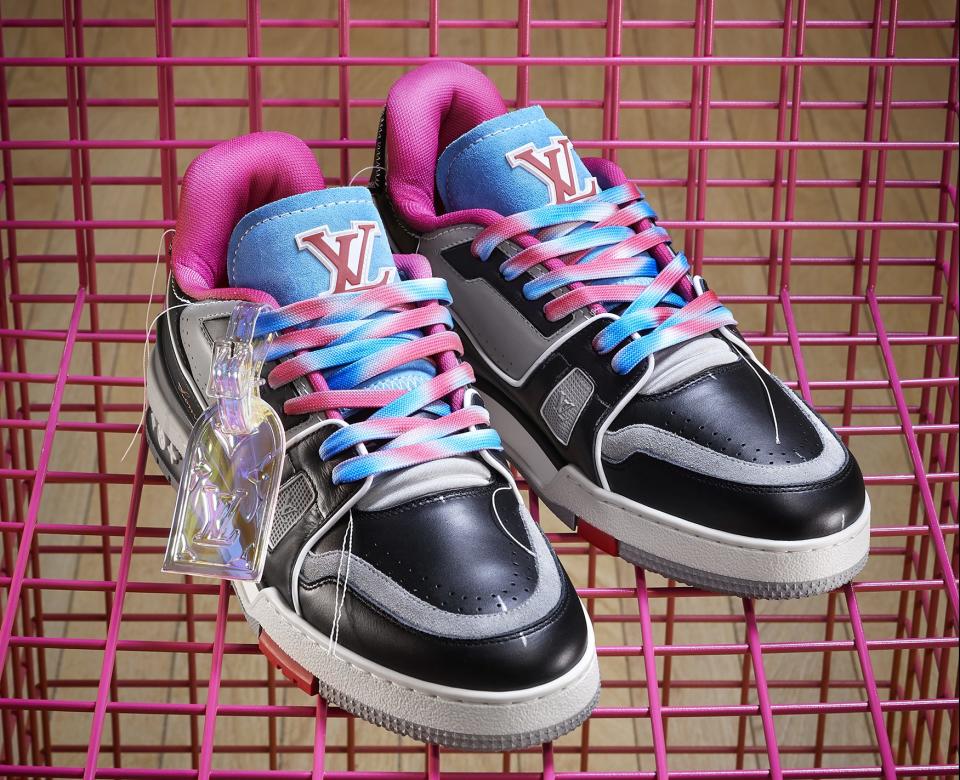EXCLUSIVE: Louis Vuitton Details Progress on Environmental Goals

In its quest to meet ambitious sustainability targets, Louis Vuitton is enlisting its clients, gently nudging them toward “delayed gratification” — and perhaps one day accepting the odd ding or scratch should the luxury giant manage to wean people off the plastic film that protects metal and glass on new products.
“We have to teach our clients that this is not environmentally friendly,” said Michael Burke, Vuitton’s chairman and chief executive officer, explaining that the company intends to “design” single-use plastic out of all of its processes.
More from WWD
Vuitton is looking into alternative protective materials and shipping methods to help eliminate the plastic film found on new shoe and belt buckles, watch faces and handbag hardware. The French luxury giant has already achieved a 16 percent reduction in single-use plastic in packaging, partly by replacing the clingy plastic that wraps pallets with reusable blankets and straps. It also introduced a broader range of box sizes to reduce its use of plastic packing fillers and to accommodate more products on trucks.
Disclosing progress on its environmental goals for the first time, Vuitton said it already reuses or recycles 93 percent of its event and window materials. In addition, 69 percent of energy to power workshops and logistics sites is renewable; 52 percent of raw materials are certified sustainable; 32 percent of its worldwide store network uses full LED lighting, and one-third of its product categories — leather goods, small leather goods, luggage, shoes and perfume — deploy an eco-design process that includes a life-cycle assessment.
The goal is to reach 100 percent on all goals by 2025 on what Vuitton calls its “committed journey.”

Cyrille GEORGE JERUSALMI
Vuitton also has a host of climate objectives for 2030 — including a 55 percent reduction in greenhouse-gas emissions — that have just been officially validated by the Science Based Targets initiative, a partnership between CDP, the United Nations Global Compact, World Resources Institute and the World Wide Fund for Nature, taking its ambitions on circular creativity and responsible sourcing to a higher level.
In an exclusive interview, Burke explained that eco practices are intrinsic to a brand like Vuitton, which has offered repairs of its products since it was founded in 1854, and which has quietly ramped up sustainability actions in recent decades.
It is now willing to talk about its progress and goals more openly, now that science-based benchmarks have been established.
“If we want to make durable, lasting, impactful change, we have to have agreed-upon ways of measuring it, or else progress will not be made, and we’ll just be stuck in PR statements,” Burke explained. “The industry has to go beyond PR statements, and get down and start doing the tedious, yearlong efforts that are required.
“This is not something that we’re just starting, but we’re starting to communicate about it because we have facts, and we have enough experience to make committed statements and goals.
“All of these efforts have to be global and mutualized,” Burke continued. “A single player will not move the needle.”
Yet Vuitton, considered the biggest luxury brand by revenue, boasts impressive eco credentials. The cash cow of LVMH Moët Hennessy Louis Vuitton’s fashion and leather goods division is the first committed to the group’s goal of reducing its carbon footprint 55 percent by 2030, with an action plan validated by the U.N.
According to Burke, all of Vuitton’s creative leaders — Nicolas Ghesquière for women’s collections, Virgil Abloh for men’s collections, and Francesca Amfitheatrof for jewelry and watches — and their teams fully embrace Vuitton’s commitment to circular creativity.
“They’re constantly toying with technology, materials and ways of making that go in this direction,” he said. “Whether it’s Nicolas, Virgil or Francesca, they all like craft.…They’re all attracted to the fundamental philosophy of luxury, that it is steeped in craft, and design occurs together with craft.
“When I hired Nicolas, what he wanted was to have access to our workshops. When I hired Virgil, he wanted access to craft,” Burke continued. “When Nicolas started designing futuristic sets for his shows, he immediately wanted to use plywood, putting everything together with screws instead of glue.”
The bulk of progress Vuitton is making on the product front stems from using sustainable raw materials, and shunning ones like virgin nylon. At present, 60 percent of wool, 67 percent of cotton, 78 percent of leather and 91 percent of gold used by Vuitton is certified to the highest environmental standards, according to the company.
Among products launched over the past year that are emblematic of Vuitton’s eco-design approach are the LV Trainers Upcycling, Charlie sneakers and its Pillow shoes and bags. Launching next month, the unisex Charlie is made using 90 percent recycled and bio-sourced materials.

Gregoire VIEILLE
Yet all product categories are subject to the same 2025 goal of an eco-design process.
Supply chain issues continue to dominate the sustainability conversation, and backlogs in ports around the world and other transportation snafus in the wake of the coronavirus pandemic have been reminders of the interconnectedness of things.
“It’s a very, very complicated and fragile ecosystem. Any disruption creates total havoc in everyone’s business, not just sustainability,” Burke said. “That shows we have to work in a very cooperative manner to modify the supply chain.”
While many e-tailers crow about rapid fulfillment, “same-day delivery anywhere in the world would be a disaster for the environment,” Burke said. “I’ve really tried to influence our sales force not to push that. Forty-eight hours allows for a much more nature-friendly supply chain.”
Vuitton’s goal is to minimize inventory as an eco measure. “We try to plan on selling one fewer rather than one more, which is intrinsic to luxury,” Burke said. “That’s why if you go to any Vuitton store in the world, as many as 50 to 100 skus may be out of stock.”
He explained that Vuitton retooled its workshops so that clusters of artisans work on an array of leather goods, rather than giant production lines focused on single styles.
“In the past, we might have made 50,000 or 100,000 units and then hoped that it would work. Today, we launch with much smaller quantities, and we only go deep when we know there’s demand,” he said. “It requires a lot more flexibility and agility across the entire organization.”
Luxury clients are already buying into some eco-friendly practices, evident in the “tremendous increase” in the demand for repairs, said Burke, noting that its workshops refurbish and fix about 500,000 handbags a year.
Over the past five years, requests for repairs increased 20 percent. Vuitton has 11 workshops dedicated to repairs across Asia, Europe, North America and the Middle East.
Leather straps attached to buckles are the most repaired feature of handbags, and Vuitton’s are engineered from the conception phase so that repairs are possible, Burke said, noting this is not the case for many leather goods that are sewn together and then simply turned inside out, obscuring how things are attached and reducing their ability to be repaired.
The executive hinted that some bags brought in for repair arrive in a sorry state, indicative of the “emotional attachment” people have with bags that have traveled with them for years.
He noted that Vuitton’s original product defined the ethos: “Nobody throws away a trunk!”
Indeed, the brand does not intend to crow much about its ecologically minded approach, considering it as intrinsic to luxury as quality, Burke said.
Sustainability is “not necessarily the first thing clients request. But it’s what makes clients loyal to a brand when they see our long-term commitment,” he explained. “It’s not going to be the foremost and first thing we’ve talked about….This is not marketing.”
In Burke’s view, “luxury is based on delayed gratification.” In this vein, Vuitton recently invited top clients to make preorders on the women’s spring 2022 runway collection shown during Paris Fashion Week on Oct. 5, with delivery in four to six months.

Giovanni Giannoni/WWD
Vuitton’s disclosure of its eco progress comes less than two weeks after environmental protesters disrupted that show, staged under the colonnades and passageways of the Louvre museum.
Burke called the invasion unfair “because the type of luxury that we witnessed is the most sustainable way of consuming that we can imagine. Those dresses are going to be held dearly within families for generations and passed down, or they’re going to end up in a museum.
“But I understand why they targeted us because we’re the number-one brand,” he said, noting that Vuitton livestreams typically garner hundreds of millions of views. “What better stage to hijack?”
However, he said the protesters were “off the mark when it comes to content,” noting that Ghesquière’s research process for the spring collection including sourcing dresses from the 17th and 18th centuries, dissecting them and reassembling them to understand “what makes these garments survive two or three centuries, and what makes them so desirable and so permanent. Even the design approach was all about sustainability.”
The brand recently introduced a new Upcycling Signal Logo, which resembles the well-known symbol for recycling originally credited to Gary Anderson, to indicate products that are either upcycled, or contain at least 50 percent of recycled and bio-sourced raw materials.

Courtesy
SEE ALSO:
Louis Vuitton Wrote the Book on Determination and Audacity
Louis Vuitton Spotlights Eco-Design Thrust With Unisex Sneaker
Virgil Abloh Has a Feeling for Eco Felt at Louis Vuitton
Sign up for WWD's Newsletter. For the latest news, follow us on Twitter, Facebook, and Instagram.

